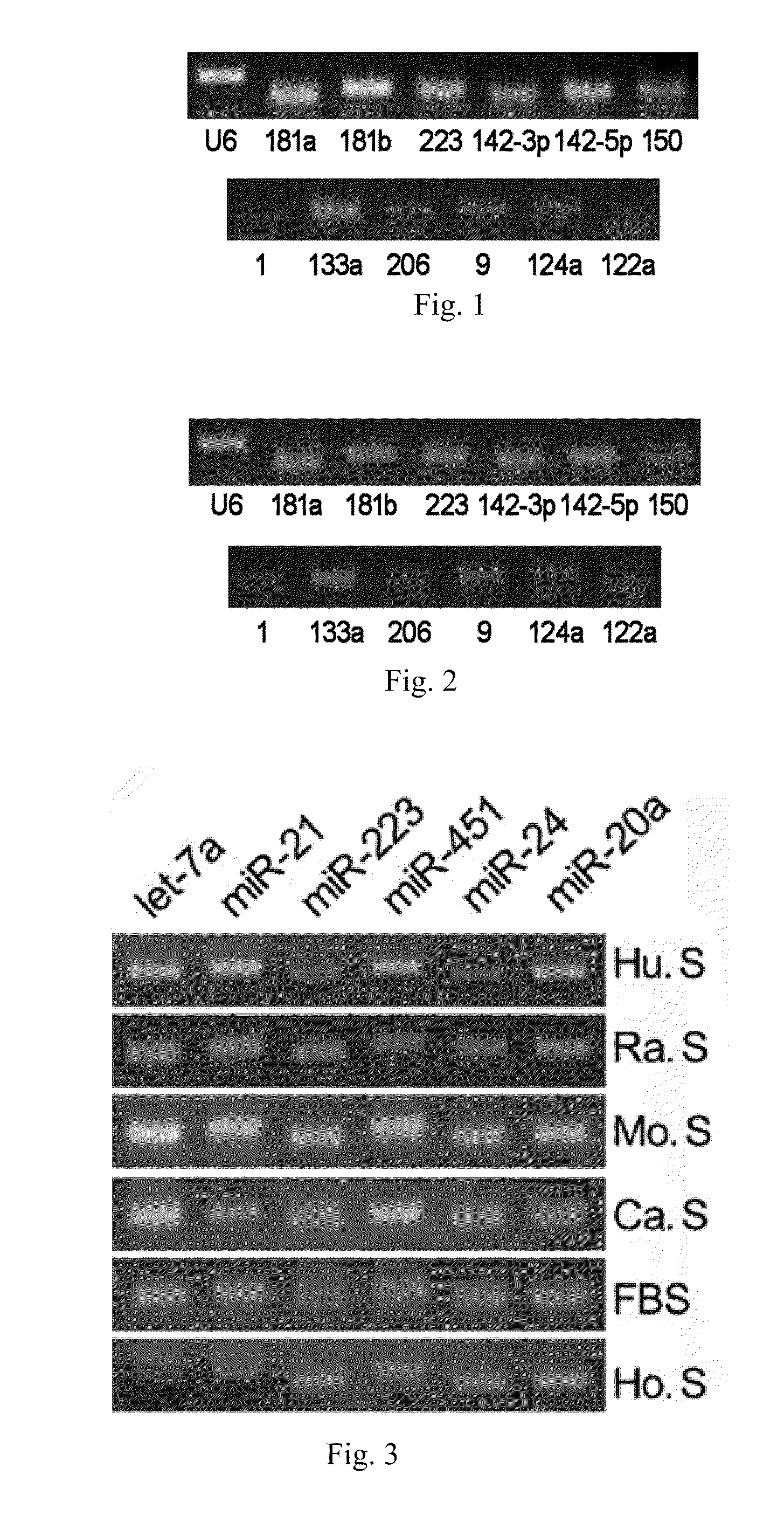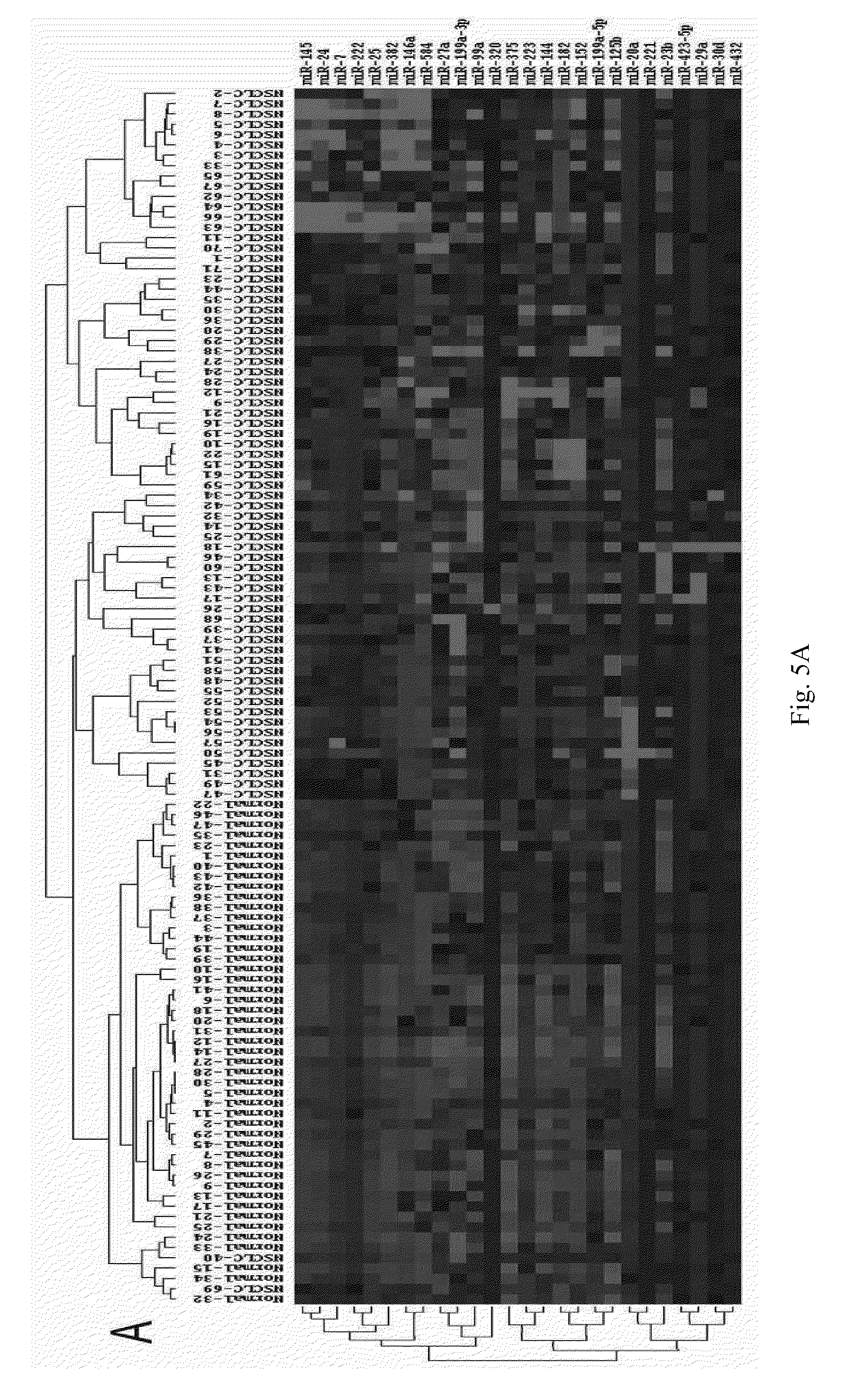Serum or plasma microrna as biomarkers for non-small cell lung cancer
a lung cancer and serum microrna technology, applied in the field of serum or plasma microrna as biomarkers for non-small cell lung cancer, can solve the problems of insufficient early stage diagnosis of cancer, inability to use detection results as accurate indicators of disease diagnosis, and inability to accurately diagnose diseas
- Summary
- Abstract
- Description
- Claims
- Application Information
AI Technical Summary
Benefits of technology
Problems solved by technology
Method used
Image
Examples
example 1
RT-PCR Experiments of microRNAs in Serum or Plasma
[0065]Using the RT-PCR assay, it has been shown that various microRNAs exist stably in serum or plasma of both human beings and other animals, and that their expression levels are considerably high. The specific steps are as follows:[0066](1) Collecting serum or plasma of mice, rats, normal subjects and patients with certain diseases.[0067](2) Preparing cDNA samples. This operation has two options: one is to directly conduct the reverse transcription reaction with 10 μl serum or plasma; the other is to firstly extract the total RNA from serum or plasma (usually, about 10 μg of RNA can be enriched by 10 μl of serum or plasma) with Trizol reagent (Invitrogen Co.), and then to obtain cDNA by the RNA reverse transcription reaction. The reaction system of reverse transcription comprises 4 μl of 5×AMV buffer, 2 μl, 10 mM of each dNTP mixture (Takara Co.), 0.5 μl of RNase Inhibitor (Takara Co.), 2 μl of AMV (Takara Co.) and 1.5 μl of gene s...
example 2
Real-Time PCR Experiments of microRNAs in Serum or Plasma
[0071]Quantitative PCR experiments on serum or plasma microRNAs are conducted in order to study the specific variations of these microRNAs during the progression of non-small cell lung cancer. The principles and steps of the quantitative experiment are the same as that of RT-PCR, except that the fluorescent dye EVA GREEN is added during PCR. An ABI Prism 7300 fluorescent quantitative PCR system is used to conduct PCR reaction under the following conditions: one cycle at 95° C. for 5 mins followed by 40 cycles at 95° C. for 15 seconds and 60° C. for 1 minute. The data processing method is the ΔΔCT method, wherein CT is the number of cycles when the reaction reaches the threshold. The expression level of each microRNA relative to an internal standard reference can be expressed by the equation 2−ΔCT, wherein ΔCT=CTsample−CTinternal reference. The reverse transcription reactions are directly conducted on serum or plasma samples of...
example 3
Biochip Utilizing Serum or Plasma MicroRNAs for the Diagnosis of Non-Small Cell Lung Cancer
[0073]The operation steps of the biochip are as follows:[0074](1) Extracting the total RNA from serum or plasma, and measuring the mass of total RNA by formaldehyde denaturing gel electrophoresis.[0075](2) Separating microRNAs: microRNAs are separated with Ambion's microRNA Isolation Kit (Cat #.1560) from 50-100 m of total RNA.[0076](3) Conducting the fluorescent labeling on microRNA samples: the microRNA samples are labeled with fluorescent labeling using the T4RNA ligase labeling method, then precipitated using absolute ethanol, and then dried before hybridization to the biochip.[0077](4) Hybridizing and rinsing: RNAs are dissolved in 16 μl of hybridizing solution (15% formamide; 0.2% SDA; 3×SSC; 50×Denhardt's solution), hybridized overnight at 42° C. After hybridization, the RNAs are rinsed for 4 mins in a solution of 0.2% SDS, 2×SSC at about 42° C., and for 4 mins in the solution of 0.2% S...
PUM
| Property | Measurement | Unit |
|---|---|---|
| Agarose Gel Electrophoresis | aaaaa | aaaaa |
| real time RT- | aaaaa | aaaaa |
| Northern blot assay | aaaaa | aaaaa |
Abstract
Description
Claims
Application Information
 Login to View More
Login to View More - R&D
- Intellectual Property
- Life Sciences
- Materials
- Tech Scout
- Unparalleled Data Quality
- Higher Quality Content
- 60% Fewer Hallucinations
Browse by: Latest US Patents, China's latest patents, Technical Efficacy Thesaurus, Application Domain, Technology Topic, Popular Technical Reports.
© 2025 PatSnap. All rights reserved.Legal|Privacy policy|Modern Slavery Act Transparency Statement|Sitemap|About US| Contact US: help@patsnap.com



